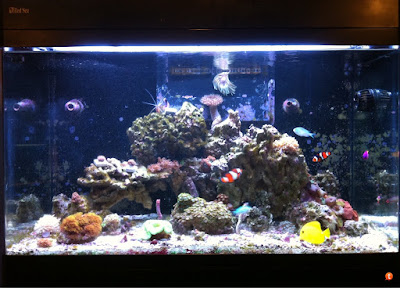Not many problems are worse to have in a saltwater aquarium than a hair algae outbreak. Once it gets a foothold in your tank, it can be a real bear to get rid of. If not handled properly it can go on for months and can lead to other problems such as loss of valuable corals. Here I will lead you to both the prevention and the cure.
SURVIVAL TIPS:
1. Get a bigger cleanup crew - You are going to need help, so spend the money and stock your tank with plenty of worker invertebrates such as algae eating snails, emerald crabs, hermit crabs, and urchins. Having the proper population of these hard working invertebrates can help prevent a hair algae outbreak in the first place. Given that they are relatively short lived, you will need to replace these invertebrates roughly twice a year. And once you have a hair algae outbreak, they are an absolute must.
2. Raise the pH to 8.4 or 8.5 and keep it there - An elevated pH helps prevent a hair algae outbreak from occurring in the first place, and is very helpful in keeping it from taking off and getting even bigger.
3. Increase water movement in the tank - One of the best conditions for a hair algae outbreak is a tank with poor water movement. Strong water movement is one of the most critical conditions in a health saltwater aquarium. It keeps organic matter and detritus suspended up in the water column where it can be removed by the mechanical filter or the protein skimmer. And it helps prevent new detritus from being able to collect on the live rock or substrate. Strong water movement also helps gas off carbon dioxide, which suppressed pH and fuels algae growth.
4. Get your phosphates and nitrates under control - Few water quality parameters are more important to get under control in a hair algae outbreak than phosphates and nitrates. These nutrients are basically fertilizers that fuel hair algae growth. And if you want to prevent a hair algae outbreak, or get rid of one, you will need to get them under control.
Phosphates should ideally be at or below 0.08ppm (parts per million). And there are several ways to reduce phosphate levels.
Use ferric oxide chemical filter media. The best way to use this media is in a substrate reactor or fluidized bed filter. It should always be in use to help prevent a hair algae outbreak, but is vitally important when battling one.
Dose kalkwasser solution (calcium hydroxide) at night. Kalkwasser has a very high pH of 14, and will help to keep the pH of your aquarium up, and it will also precipitate out phosphates so that your protein skimmer can remove them.
Increase water changes. If your normal rate of water changes was 25% of your total system volume per month, then I would recommend doubling it to 50% per month until the hair algae outbreak is under control.
Rinse your frozen foods. If you thaw out any of the commercially prepared frozen foods that are sold for saltwater aquarium fish, you will see a dark and filthy soup left behind. This soup is loaded with phosphates, nitrates and other nutrients that fuel hair algae growth. I strongly recommend you pour the thawed out frozen food through a fish net (I use a brine shrimp net) and then rinse the food with some aquarium water. This will get rid of the nutrients before you add the food to your aquarium
Use "R.O.D.I." water. This stands for reverse osmosis water that has been post filtered through de-ionization resins. This is the most sure way to prevent the addition of phosphates and silicates, or other contaminants, to your aquarium.
Use activated carbon to remove dissolved organics, which can help fuel hair algae growth
5. Jump in and help out - To help your algae-grazing invertebrates get the hair algae outbreak under control, you will need to help give them a jump start by manually removing as much of the hair algae as possible. This will need to be done at least once a week until the problem is resolved.
6. Make sure your protein skimmer is working at peak efficiency - Given that hair algae thrives on dissolved organics, a properly operating protein skimmer is going to be key to battling a hair algae outbreak. Instead of the once a week cleaning, I would recommend twice a week. Also, make sure that the air intake or venturi on your protein skimmer is not clogged or otherwise restricted.
In the end, the best approach is prevention. It may be a lot of work, but preventative maintenance is the cheapest work, and it is nothing compared to the frustrating struggle of fighting a full blown hair algae outbreak.
Have you ever been to a big public aquarium and wondered 'how do they do that'?. Would you like to have FREE access to our years of "been-there-done-that" wisdom and experience working in public aquariums, and in the design, installation, and maintenance of large custom saltwater aquariums that rock? Clients have paid us well over $100,000 for custom installations and now you can get the same information for free. And in addition to receiving our free newsletter with behind the scenes secrets, tips and advice, we will provide how-to videos, and interviews with experts and authors.







Tidak ada komentar:
Posting Komentar